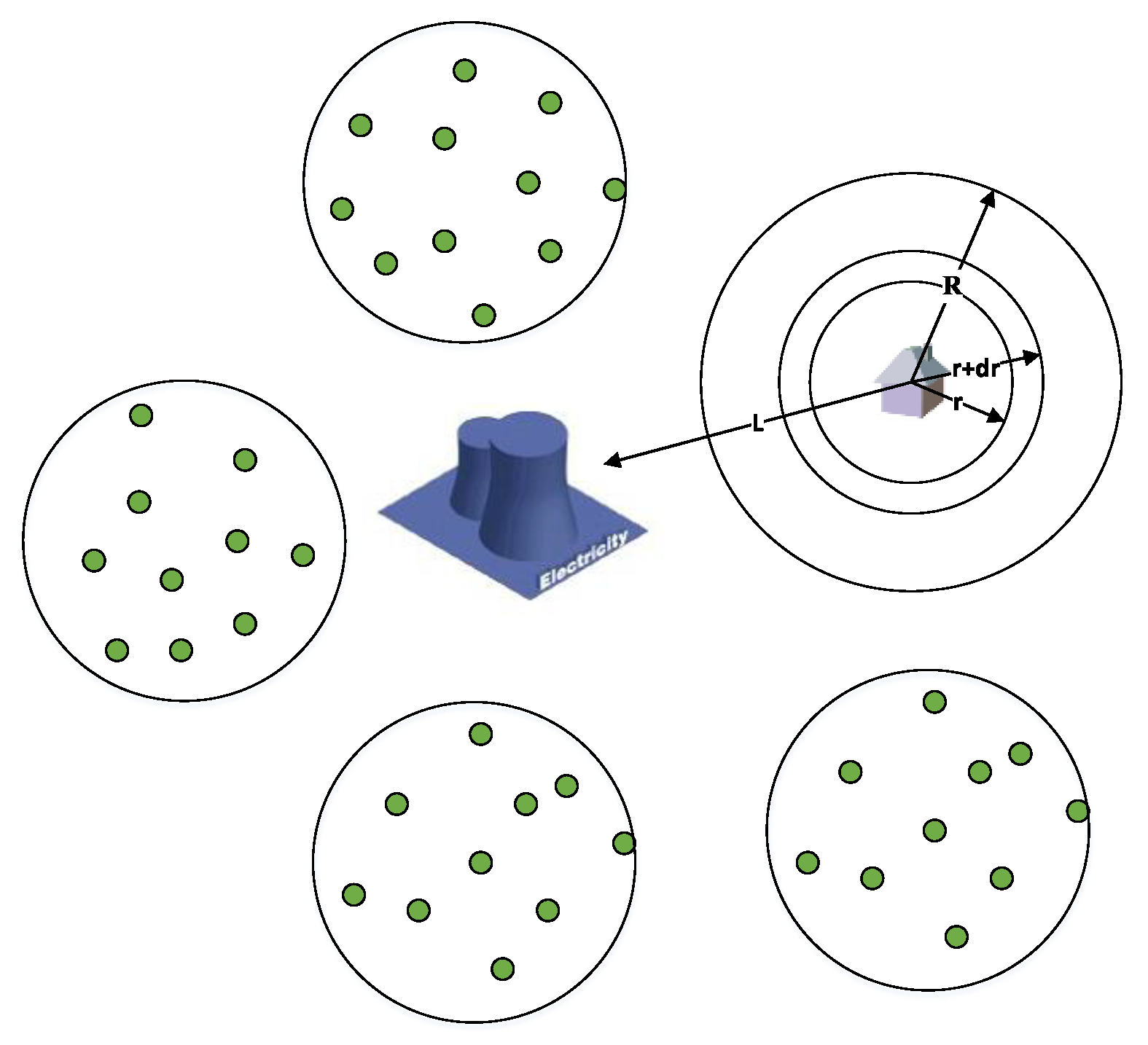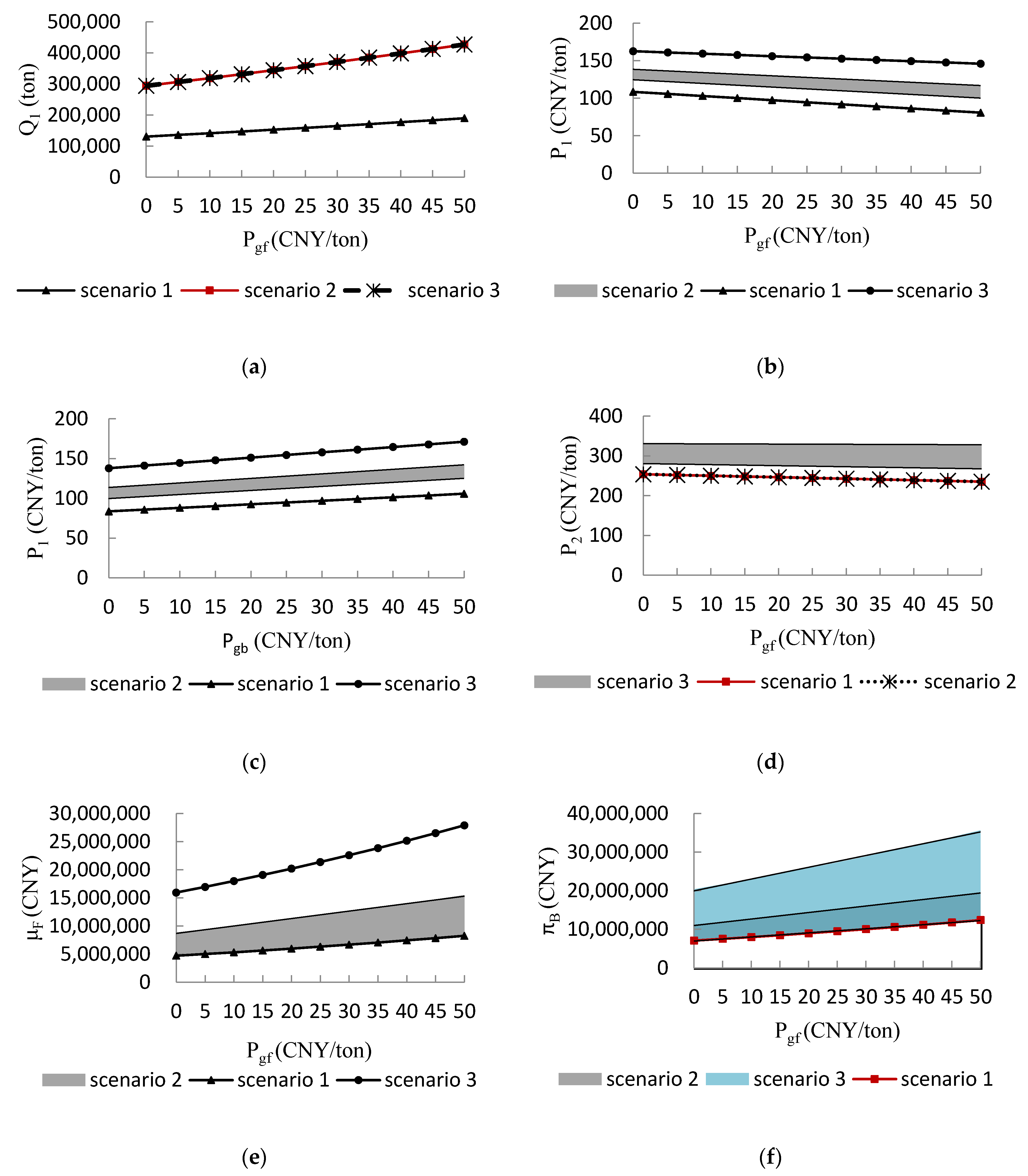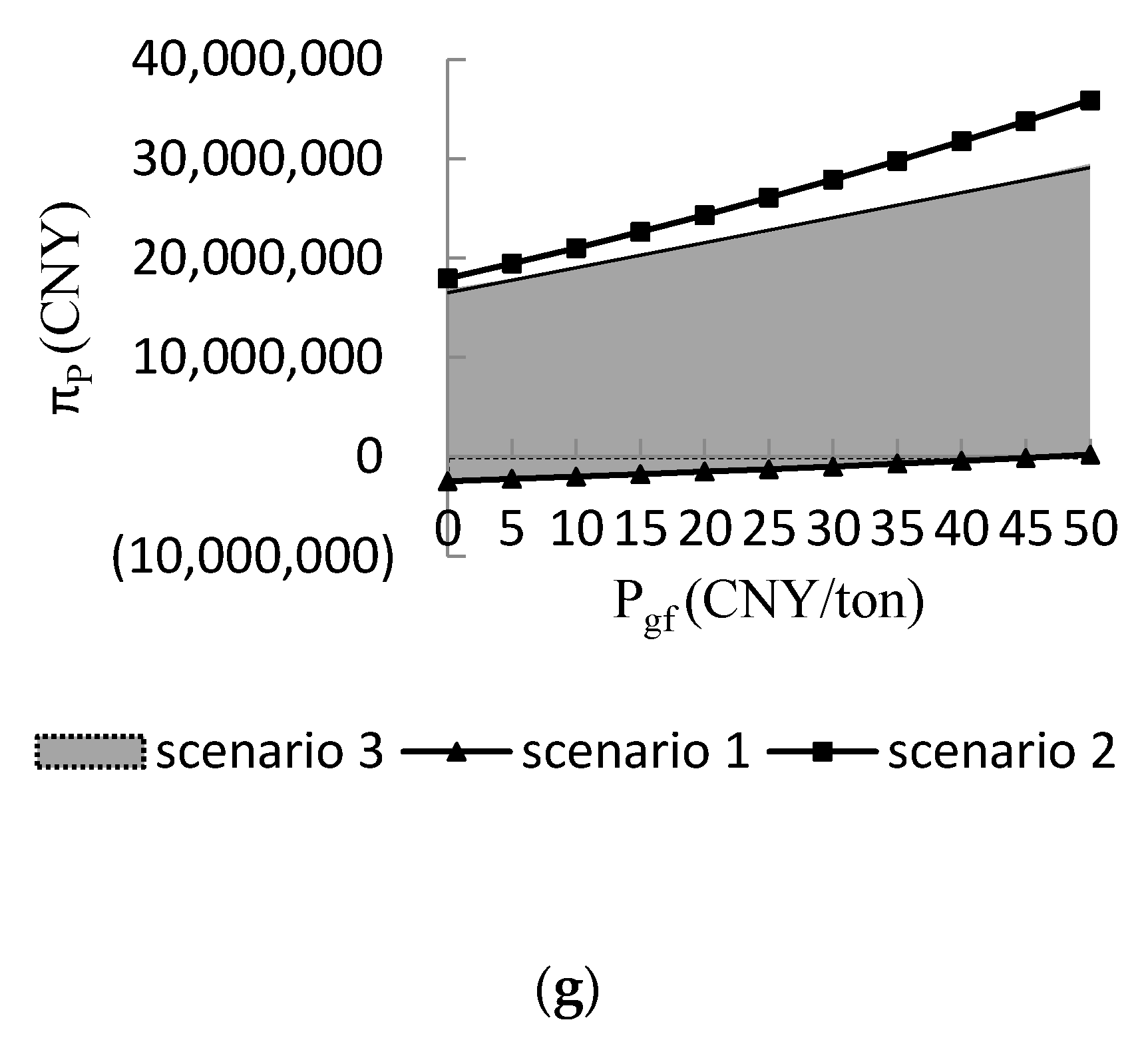A Game-Theoretic Analysis of Incentive Effects for Agribiomass Power Generation Supply Chain in China
Abstract
1. Introduction
2. The Stackelberg Game Model
2.1. The Players of Agribiomass Power Generation Supply Chain
2.2. Assumptions
- China implements a household responsibility system in agriculture; the agribiomass holders are thousands of scattered small-scale farmers [19]. For geometrical simplicity, we assume the biomass power plant is in the central position; the biomass storage station is at the center of the agribiomass collection area with radius R [34], as shown in Figure 2. Considering the complexity of the road, tortuosity factor β is introduced to adjust transport distance, so the transportation cost from each supply point to the biomass storage station (CNY) can be calculated by the following integral:whereIfThen, the cost of agribiomass transportation from each supply point to the biomass storage station is given by:where (CNY/km·ton) denotes the unit cost of agribiomass transportation from each supply point to the biomass storage station, represents the agribiomass output in a unit area (ton/km2), and k is the agribiomass collection coefficient.For the ease of subsequent calculations, the unit transportation cost of agribiomass transportation from the biomass storage station to the biomass power plant (CNY/ton) can be calculated as:where (CNY/km·ton) denotes the unit cost of agribiomass transportation from the biomass storage station to the biomass power plant, and (km) represents the average transport distance from the biomass storage station to the biomass power plant.
- As byproduct of the regular crops, the agribiomass was acquired by farmers unintentionally. If the agribiomass cannot be collected, it is likely to be discarded directly in field. Thus, opportunity cost need not to be considered in the analysis.
- This study assumes that different type of agribiomass has no impact on the agribiomass price, collection, transportation, and storage.
- This study assumes that agribiomass production and supply are all calculated on yearly basis; seasonal and climate factors are neglected for convenience in calculation.
- This study assumes that the total amount of agribiomass in the collection area is sufficient. In order to prevent vicious competition for feedstock, there is only one biomass power plant in the research area [9].
2.3. Payoff Functions
2.3.1. The Noncooperative Game Formulation
2.3.2. The Cooperative Game Formulation
- The farmer–broker cooperative game
- 2.
- The broker–biomass power plant cooperative game
3. Equilibrium
3.1. Equilibrium of the Noncooperative Game
3.2. Equilibrium of the Cooperative Game
3.2.1. The Farmer–Broker Cooperative Game
3.2.2. The Broker–Biomass Supply Chain Cooperative Game
4. Numerical Examples
4.1. Case Description and Results
4.2. Sensitivity Analysis
- (1)
- , both the cooperative game models can bring the same higher agribiomass supply quantity. The agribiomass supply quantity will meet the demand of the biomass power plant under certain government incentives and cooperative structures.
- (2)
- , and , both the broker and the biomass power plant pay the highest purchase price in the broker–biomass power plant cooperative game. Although they will provide a higher price to purchase agribiomass in two cooperative game models, the profits of all biomass supply chain members have increased.
- (3)
- , , , the optimal profit of farmer, broker, and biomass power plant have all increased in both cooperative game models, and the biomass power plant will turn loss into gain under certain circumstances. Meanwhile, the farmer can get the maximum profit in the broker–biomass power plant cooperative game, while the biomass power plant makes the maximum profit in the farmer–broker cooperative game. The possible reasons may be that cooperation of some parties would often result in the maximum benefit of the isolated party. The broker’s maximum profit is determined by and .
5. Conclusions
Author Contributions
Funding
Institutional Review Board Statement
Informed Consent Statement
Data Availability Statement
Conflicts of Interest
Appendix A
Appendix A.1. Proof of Proposition 1
Appendix A.2. Proof of Proposition 2
Appendix A.3. Proof of Proposition 3
References
- Zahraee, S.M.; Golroudbary, S.R.; Shiwakoti, N.; Kraslawski, A.; Stasinopoulos, P. An investigation of the environmental sustainability of palm biomass supply chains via dynamic simulation modeling: A case of Malaysia. J. Clean. Prod. 2019, 237, 117740. [Google Scholar] [CrossRef]
- Chen, X. Economic potential of biomass supply from crop residues in China. Appl. Energy 2016, 166, 141–149. [Google Scholar] [CrossRef]
- Pan, X.; Chen, W.; Wang, L.; Lin, L.; Li, N. The role of biomass in China’s long-term mitigation toward the Paris climate goals. Environ. Res. Lett. 2018, 13, 124028. [Google Scholar] [CrossRef]
- Yang, X.J.; Hu, H.; Tan, T.; Li, J. China’s renewable energy goals by 2050. Environ. Dev. 2016, 20, 83–90. [Google Scholar] [CrossRef]
- Zhao, Z.-Y.; Zuo, J.; Fan, L.-L.; Zillante, G. Impacts of renewable energy regulations on the structure of power generation in China–a critical analysis. Renew. Energy 2011, 36, 24–30. [Google Scholar] [CrossRef]
- Lin, B.; He, J. Is biomass power a good choice for governments in China? Renew. Sustain. Energy Rev. 2017, 73, 1218–1230. [Google Scholar] [CrossRef]
- Royo, J.; Sebastián, F.; García-Galindo, D.; Gómez, M.; Díaz, M. Large-Scale analysis of GHG (greenhouse gas) reduction by means of biomass co-firing at country-scale: Application to the Spanish case. Energy 2012, 48, 255–267. [Google Scholar] [CrossRef]
- Liu, H.; Polenske, K.R.; Xi, Y.; Guo, J.-E. Comprehensive evaluation of effects of straw-based electricity generation: A Chinese case. Energy Policy 2010, 38, 6153–6160. [Google Scholar] [CrossRef]
- He, J.; Zhu, R.; Lin, B. Prospects, obstacles and solutions of biomass power industry in China. J. Clean. Prod. 2019, 237, 117783. [Google Scholar] [CrossRef]
- Lund, H.; Mathiesen, B.V. Energy system analysis of 100% renewable energy systems—The case of Denmark in years 2030 and 2050. Energy 2009, 34, 524–531. [Google Scholar] [CrossRef]
- Zhang, Q.; Zhou, D.; Fang, X. Analysis on the policies of biomass power generation in China. Renew. Sustain. Energy Rev. 2014, 32, 926–935. [Google Scholar] [CrossRef]
- Xingang, Z.; Jieyu, W.; Xiaomeng, L.; Tiantian, F.; Pingkuo, L. Focus on situation and policies for biomass power generation in China. Renew. Sustain. Energy Rev. 2012, 16, 3722–3729. [Google Scholar] [CrossRef]
- Liang, Y.; Yu, B.; Wang, L. Costs and benefits of renewable energy development in China’s power industry. Renew. Energy 2019, 131, 700–712. [Google Scholar] [CrossRef]
- Zhang, Q.; Zhou, D.; Zhou, P.; Ding, H. Cost analysis of straw-based power generation in Jiangsu Province, China. Appl. Energy 2013, 102, 785–793. [Google Scholar] [CrossRef]
- Liu, L.; Ye, J.; Zhao, Y.; Zhao, E. The plight of the biomass power generation industry in China–A supply chain risk perspective. Renew. Sustain. Energy Rev. 2015, 49, 680–692. [Google Scholar] [CrossRef]
- Wang, C.; Zhang, L.; Chang, Y.; Pang, M. Biomass direct-fired power generation system in China: An integrated energy, GHG emissions, and economic evaluation for Salix. Energy Policy 2015, 84, 155–165. [Google Scholar] [CrossRef]
- Liu, J.; Wang, S.; Wei, Q.; Yan, S. Present situation, problems and solutions of China’s biomass power generation industry. Energy Policy 2014, 70, 144–151. [Google Scholar] [CrossRef]
- Wang, L.; Watanabe, T. Factors affecting farmers’ risk perceptions regarding biomass supply: A case study of the national bioenergy industry in northeast China. J. Clean. Prod. 2016, 139, 517–526. [Google Scholar] [CrossRef]
- Jiang, D.; Zhuang, D.; Fu, J.; Huang, Y.; Wen, K. Bioenergy potential from crop residues in China: Availability and distribution. Renew. Sustain. Energy Rev. 2012, 16, 1377–1382. [Google Scholar] [CrossRef]
- Qu, W.; Tu, Q.; Bluemling, B. Which factors are effective for farmers’ biogas use?—Evidence from a large-scale survey in China. Energy Policy 2013, 63, 26–33. [Google Scholar] [CrossRef]
- Boschetti, L.; Roy, D.P.; Justice, C.O.; Humber, M.L. MODIS–Landsat fusion for large area 30 m burned area mapping. Remote Sens. Environ. 2015, 161, 27–42. [Google Scholar] [CrossRef]
- Wang, Z.; Wang, Z.; Tahir, N.; Wang, H.; Li, J.; Xu, G. Study of synergetic development in straw power supply chain: Straw price and government subsidy as incentive. Energy Policy 2020, 146, 111788. [Google Scholar] [CrossRef]
- Nasiri, F.; Zaccour, G. An exploratory game-theoretic analysis of biomass electricity generation supply chain. Energy Policy 2009, 37, 4514–4522. [Google Scholar] [CrossRef]
- Sun, J.; Lin, J.; Qian, Y. Game-Theoretic analysis of competitive agri-biomass supply chain. J. Clean. Prod. 2013, 43, 174–181. [Google Scholar] [CrossRef]
- Zhang, X.; Luo, K.; Tan, Q. A feedstock supply model integrating the official organization for China’s biomass generation plants. Energy Policy 2016, 97, 276–290. [Google Scholar] [CrossRef]
- Wang, L.; Watanabe, T. A stackelberg game theoretic analysis of incentive effects under perceived risk for China’s straw-based power plant supply chain. Energies 2016, 9, 455. [Google Scholar] [CrossRef]
- Ye, F.; Li, Y.; Lin, Q.; Zhan, Y. Modeling of China’s cassava-based bioethanol supply chain operation and coordination. Energy 2017, 120, 217–228. [Google Scholar] [CrossRef]
- Wen, W.; Zhang, Q. A design of straw acquisition mode for China’s straw power plant based on supply chain coordination. Renew. Energy 2015, 76, 369–374. [Google Scholar] [CrossRef]
- Wen, W.; Zhou, P. Impacts of regional governmental incentives on the straw power industry in China: A game-theoretic analysis. J. Clean. Prod. 2018, 203, 1095–1105. [Google Scholar] [CrossRef]
- Mafakheri, F.; Nasiri, F. Modeling of biomass-to-energy supply chain operations: Applications, challenges and research directions. Energy Policy 2014, 67, 116–126. [Google Scholar] [CrossRef]
- Ghaderi, H.; Pishvaee, M.S.; Moini, A. Biomass supply chain network design: An optimization-oriented review and analysis. Ind. Crop. Prod. 2016, 94, 972–1000. [Google Scholar] [CrossRef]
- Tan, Q.; Wang, T.; Zhang, Y.; Miao, X.; Zhu, J. Nonlinear multi-objective optimization model for a biomass direct-fired power generation supply chain using a case study in China. Energy 2017, 139, 1066–1079. [Google Scholar] [CrossRef]
- Sharma, B.; Ingalls, R.G.; Jones, C.L.; Khanchi, A. Biomass supply chain design and analysis: Basis, overview, modeling, challenges, and future. Renew. Sustain. Energy Rev. 2013, 24, 608–627. [Google Scholar] [CrossRef]
- Overend, R. The average haul distance and transportation work factors for biomass delivered to a central plant. Biomass 1982, 2, 75–79. [Google Scholar] [CrossRef]
- Wu, Y.; Li, L.; Xu, R.; Chen, K.; Hu, Y.; Lin, X. Risk assessment in straw-based power generation public-private partnership projects in China: A fuzzy synthetic evaluation analysis. J. Clean. Prod. 2017, 161, 977–990. [Google Scholar] [CrossRef]




| Parameters | Values | Parameters | Values |
|---|---|---|---|
| β | 1.5 | k | 0.3 |
| ct1 (CNY/km·ton) | 2 | α (ton/km2) | 153 |
| ct2 (CNY/km·ton) | 1.5 | L (km) | 20 |
| θ | 0.1 | CS (CNY/Ton) | 50 |
| POC (CNY/kWh) | 0.32 | Pe (CNY/kWh) | 0.75 |
| CSP (million CNY) | 10 | γ (kWh/ton) | 800 |
Publisher’s Note: MDPI stays neutral with regard to jurisdictional claims in published maps and institutional affiliations. |
© 2021 by the authors. Licensee MDPI, Basel, Switzerland. This article is an open access article distributed under the terms and conditions of the Creative Commons Attribution (CC BY) license (http://creativecommons.org/licenses/by/4.0/).
Share and Cite
Wu, J.; Zhang, J.; Yi, W.; Cai, H.; Li, Y.; Su, Z. A Game-Theoretic Analysis of Incentive Effects for Agribiomass Power Generation Supply Chain in China. Energies 2021, 14, 546. https://doi.org/10.3390/en14030546
Wu J, Zhang J, Yi W, Cai H, Li Y, Su Z. A Game-Theoretic Analysis of Incentive Effects for Agribiomass Power Generation Supply Chain in China. Energies. 2021; 14(3):546. https://doi.org/10.3390/en14030546
Chicago/Turabian StyleWu, Juanjuan, Jian Zhang, Weiming Yi, Hongzhen Cai, Yang Li, and Zhanpeng Su. 2021. "A Game-Theoretic Analysis of Incentive Effects for Agribiomass Power Generation Supply Chain in China" Energies 14, no. 3: 546. https://doi.org/10.3390/en14030546
APA StyleWu, J., Zhang, J., Yi, W., Cai, H., Li, Y., & Su, Z. (2021). A Game-Theoretic Analysis of Incentive Effects for Agribiomass Power Generation Supply Chain in China. Energies, 14(3), 546. https://doi.org/10.3390/en14030546





